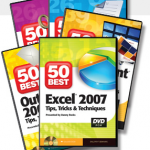When I create the examples for this podcast I frequently use the =RANDBETWEEN() function to generate random numbers. Then, I usually copy the formulas and use Paste Special to convert them into values.
Recently, I watched Bill Jelen. Mr. Excel demonstrate an absolutely amazing Excel Trick – use your Right-mouse button to move a selected block of cells over the the right. And then, without releasing the mouse button, move the block of cells back into place. A menu pops up and asks if you want to “Copy here as Values.” Try it! It is amazing! What a time-saver!
Here are the steps to follow in the Excel Video Lesson:
- Use the =RANDBETWEEN() Function to generate random numbers in your Excel spreadsheet. The function takes two arguments – a Top Number and a Bottom Number (both of your choosing.)
- The RANDBETWEEN Function is part of the Analysis ToolPak Add-IN. Activate it by choosing Tools – Add-Ins- Analysis ToolPak.
- Select the block of cells before you write the formula and then use Ctrl+Enter to populate all of the cells in your selected range with the formula.
- To convert the formulas to values, use Copy, Paste Special Values.
- OR… try this incredible trick (courtesy of Bill Jelen, Mr. Excel: Select the block of cells. With the RIGHT-Mouse Button, move the Border of the cell range over the the right and then back into place. Then, when you release the mouse a menu pops up. Choose, “Copy as Values Here.” It is amazining!


